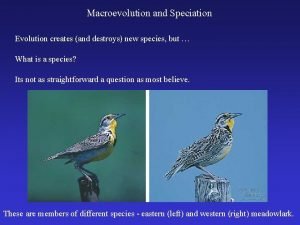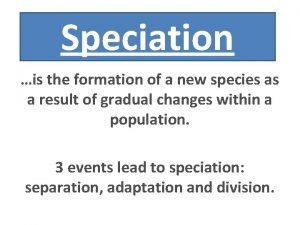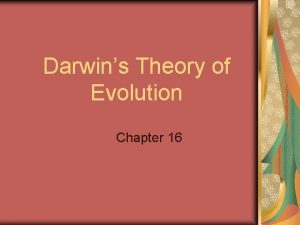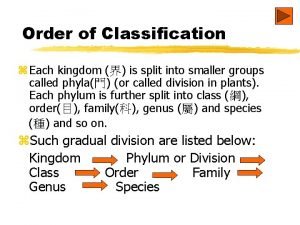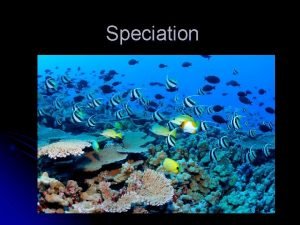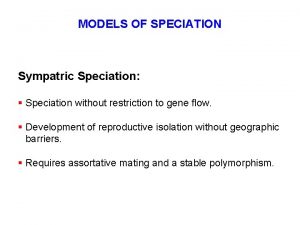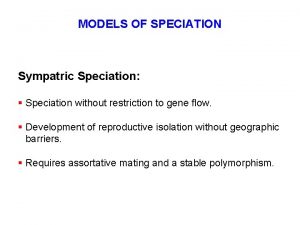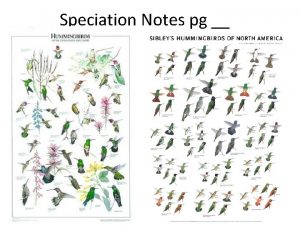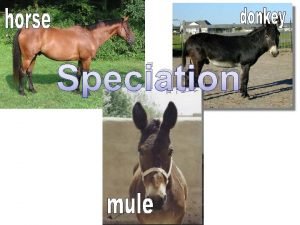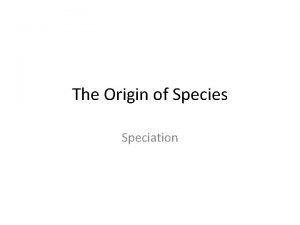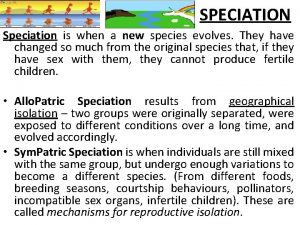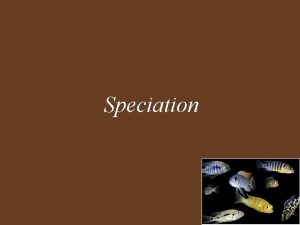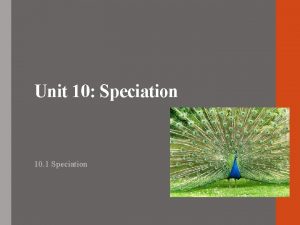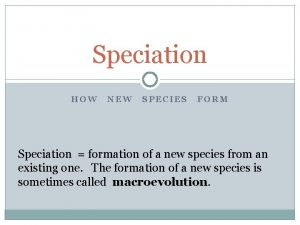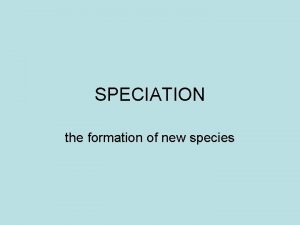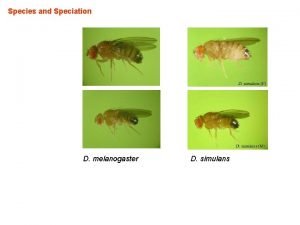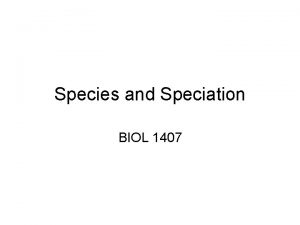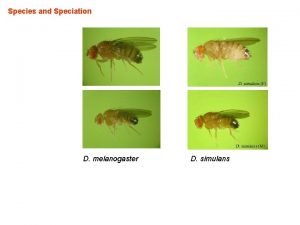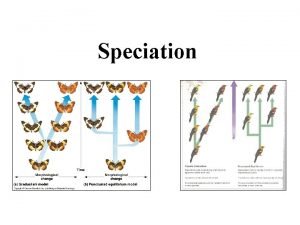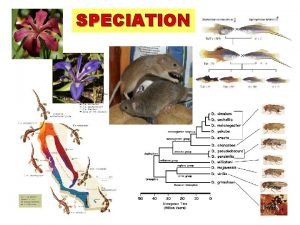Species Speciation n Main Points for Class Meeting























- Slides: 23

Species & Speciation n Main Points for Class Meeting: 1. How do new species arise? 2. How do we organize species diversity? 3. How many species are there? ?

Review – Genetic Variation & Inheritance Track a trait based on what we learned in our last class session: n “Widow’s peak” is dominant n No widow’s peak is recessive n Example on board n

What are some sources of genetic variation? Mutation n Sexual reproduction – the sorting & recombination of genes from both parents leads to an almost endless set of different traits n Phenotypes & genotypes… n

What happens when a species loses genetic diversity? n Example: The Cheetah

What – again – makes a species distinct? The Biological species concept: Species: A population whose members can interbreed to produce healthy, fertile offspring.

1. How do new species arise? Via Speciation: The keystone process in the formation of diversity in higher taxa. n Copyright © 2002 Pearson Education, Inc. , publishing as Benjamin Cummings

n Two patterns of speciation: 1) Accumulation of changes as one species is transformed into another (= “vertical change” – Wilson ch. 5) Fig. 24. 1 a Copyright © 2002 Pearson Education, Inc. , publishing as Benjamin Cummings

n Two patterns of speciation: 2) Branching evolution: the budding of new species from a parent species n Which type increases diversity? Fig. 24. 1 b Copyright © 2002 Pearson Education, Inc. , publishing as Benjamin Cummings

1. How do new species arise? (cont’d) n n For new species to arise, gene flow between populations must be interrupted. How might this occur? In your groups, discuss some possible mechanisms. Copyright © 2002 Pearson Education, Inc. , publishing as Benjamin Cummings

Allopatric speciation occurs when geographic separation of populations restricts gene flow. Fig. 24. 6

n n n Geological processes: isolate populations from each other E. g. : Mountain ranges, glaciers, land bridges, splintering of lakes… OR, some individuals may colonize a new, geographically remote area and become isolated from the parent population. n e. g. Galapagos Islands Copyright © 2002 Pearson Education, Inc. , publishing as Benjamin Cummings

How significant a barrier must be to limit gene exchange depends on the mobility of organisms. n A geological feature that is only a minor hindrance to one species may be an impassible barrier to another. n n The valley of the Grand Canyon is a significant barrier for ground squirrels which have speciated on opposite sides, but birds which can move freely have no barrier. Fig. 24. 7 Copyright © 2002 Pearson Education, Inc. , publishing as Benjamin Cummings

n n When populations come back in contact they may or may not interbreed and produce fertile offspring. Has speciation occurred in the 2 scenes below? Fig. 24. 8 Copyright © 2002 Pearson Education, Inc. , publishing as Benjamin Cummings

2. How do we organize species diversity? This is the area of biology called Phylogeny n We make “family trees” n Copyright © 2002 Pearson Education, Inc. , publishing as Benjamin Cummings

What is the taxonomic hierarchy used by biologists to organize diversity? n Mnemonic device for remembering the levels of the hierarchy…?


3 Domains http: //www. ucmp. berkeley. edu/alllife/threedomains. html

6 (+? ) Kingdoms DOMAIN ARCHAEA

Assignment: Choose an organism you know or have found (on campus, at your home, somewhere you’ve visited) n Figure out what it is, as closely as possible n Make a “Family Tree” for your organism – classify it according the taxonomic hierarchy, to the lowest level you can! n

3. How Many Species? n n n How many known species are there? (approximately…) (Wilson ch. 8) What proportion of species have we probably described? Why are we so uncertain about the numbers of species on Earth?

3. How Many Species? n n Examples of groups of organisms that are mostly unknown Why is the case?


(3. How Many Species? ) n Species diversity can be measured at 3 scales, for comparison of sites in different areas Alpha (local) & gamma (regional) diversity, & beta diversity or turn-over between sites http: //www. redpath-museum. mcgill. ca/Qbp/2. About%20 Biodiversity/definition. htm
 Isolating mechanism
Isolating mechanism Speciation, or the formation of new species, is
Speciation, or the formation of new species, is Mountain lion keystone species
Mountain lion keystone species Bull's eye brand positioning
Bull's eye brand positioning Points of parity and points of difference
Points of parity and points of difference Species vary locally main idea
Species vary locally main idea For todays meeting
For todays meeting Today meeting or today's meeting
Today meeting or today's meeting What is meeting and types of meeting
What is meeting and types of meeting Types of meeting
Types of meeting Science of naming and classifying organisms
Science of naming and classifying organisms Domain kingdom phylum class order family genus species
Domain kingdom phylum class order family genus species Mnemonic for kingdom phylum
Mnemonic for kingdom phylum Kingdom phylum class
Kingdom phylum class Domain kingdom phylum
Domain kingdom phylum Domain kingdom phylum class order family genus species
Domain kingdom phylum class order family genus species Federalist paper 78
Federalist paper 78 Letter from birmingham jail 3 main points
Letter from birmingham jail 3 main points What is lahore resolution in urdu
What is lahore resolution in urdu Main points of federalist 78
Main points of federalist 78 What is a supporting point
What is a supporting point Redemptor hominis summary
Redemptor hominis summary Strategic organization means putting a speech together
Strategic organization means putting a speech together Multi-channeled definition in communication
Multi-channeled definition in communication
